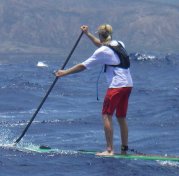Paddle Technique Part 4: Reach and Catch by Robert Stehlik
 This shot from the 2009 Molokai race does not show perfect form
This shot from the 2009 Molokai race does not show perfect form
but I am reaching pretty far forward
I started the technique series with the power phase as this is where I saw the quickest improvements when coaching. All the phases of the stroke have to work together smoothly for the stroke to be efficient and without good reach and catch, the stroke won’t be effective. I already started working on a technique post on breathing but before I get into that I really want to go back to what should have probably been part one of the technique posts: the Reach!

(click thumbnail to launch video)
Work Out vs. Practice
I used to think that SUP racing is mostly a contest of endurance and muscle power. I worked out hard hoping to become more fit than the competition. As I spent more time on the water and paddling with others, I realized that technique and efficiency are often more important and usually play a bigger role than overall fitness in race results. When training the focus should be on practicing good technique and not just “working out”. Fitness is important, of course, and comes as a bi product of practice. By practicing good technique when training you will train the right muscles to do the right thing automatically when racing. If your technique is bad, “working out” can actually be counter productive. By working out the wrong muscles, muscle memory can make it harder to change the stroke to make it more efficient later.
Reaching forward as far as possible will make the stroke longer and more efficient. The most effective part of the power phase occurs well in front of the feet. The further forward you can begin the power phase, the better. If your paddle is too short, you will not be able to achieve good reach, so make sure you have a long enough paddle first, see “choosing the right paddle”
Reach:
Pay attention to how far forward you currently reach when stroking and try to go further. There are several ways of extending your reach. First of all, keep a loose grip with the lower hand and open the lower fingers up to allow the paddle to reach a more forward angle. Straighten your bottom arm and stretch it forward by twisting the shoulder and hip forward. Bend the elbow on your top arm to angle the paddle forward more. Practice this and keep trying to reach further and further forward.
Catch:
You can have great reach but if you don’t plant the blade in the water effectively and quickly for a good catch, much of the great reach can be wasted. To “catch”, the blade can be slid into the water from the side or by projecting it straight down into the water, usually a little of both. Either way, the focus should be on entering the water smoothly and quickly with the paddle edge slicing into the water cleanly, creating minimal turbulence.
Once the blade is fully submerged and “planted” it’s time to apply the power. If you start pulling too soon, the blade tends to cavitate (air bubbles form along edges of blade) and will slip through the water instead of holding.
A good way to practice efficient strokes with a clean catch, power phase, and release is what I call “stealth mode”. It works best on a calm, quiet day (or night). Go into stealth mode by making as little noise with your paddle as possible. If your paddle splashes on the catch, try to make the entry smoother and don’t pull on the paddle before the blade is submerged. If the paddle is gurgling through the power phase, focus on really planting the whole blade in the water before applying the power (think of “surprising” the water). If you are splashing water behind you, try to end the power phase sooner (keep it in front of your feet) and release the paddle smoothly.
A good way to practice your reach is from Danny Ching’s technique DVD: Practice just the reach: Put your blade in the water as far forward as possible but don’t pull, just take the paddle back out and repeat this a few times to really focus on just the reach and catch.
More reading:
Reach, Dammit, Reach by Dave Kalama
Paddle Technique Part 2: The Power Phase
Paddle Technique Part 3: Stacking the Shoulders
For more tips from Robert, visit his Zen Waterman blog at http://zenwaterman.blogspot.com/.



0 Responses to “Paddle Technique Part 4: Reach and Catch by Robert Stehlik”